Mints, Dead-nettles, Sages & Allies
The family Lamiaceae is a fairly large family of plants in our region and includes a lot of familiar species. This family was formerly known as the Labiatae (after its two-lipped flowers) and from this, the term 'labiates' was coined. Many members of the labiate family are well known either as garden ornamentals, or as culinary or medicinal herbs. Such plants include thymes, sages, cat-mints, Rosemary and others. In general terms, members of this family can be recognised by their opposite leaves, four-sided stems and their flowers, which have tubular bases and open into a two-lipped mouth. Most members of the family also tend to be hairy and many are highly aromatic. As this is such a large group, this page will help narrow your search, once you have arrived here from the flower colour pages.
The main purpose of this page is to attempt to break this family up into manageable groups, so that the pages you are led to do not get too big by containing a large number of species. At worst, if you follow a link from here and do not see your plant, return to this page and try another link. Note that some species may come in a variety of flower colours; in such cases, the species may be shown on more than one page, so you should still find it. In particular, many of the red-flowered species can occasionally be found with pink or white flowers, where the red-colouring is reduced or absent in the plant.
Be sure to read the texts below carefully, as they contain identification information that may not be visible in the photographs; clicking to the next stage will help you get to the exact species. It is important at this stage to not only look at flower colour but also to look at the structure of the petals (their number and size/shape) and to check for the presence or absence of a woody base. Later it will be helpful to note details of leaves and any stem hairs that may be present.
Use the photos below to narrow your search to a group, then click on the picture to go to the next stage.
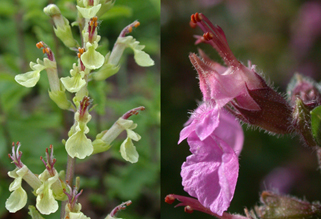 |
Germanders
The germanders have many of the classic features of the labiate family, including opposite, hairy leaves, square stems and tubular-based flowers. However, the flowers differ from those of other labiates by having no upper lip at the mouth of the flower, resulting in the long stamens being particularly prominent. Flowers come in a variety of colours. |
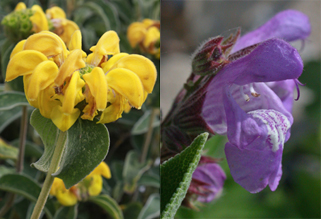 |
Woody Labiates
This is a loose assemblage of members of the labiate family, which are perennial, shrubby species that develop woody bases as they age. Flowers are blue or purple for most species, but may also be white, pink or yellow. They share the typical labiate flower shape and are usually aromatic (crush a leaf and smell!). |
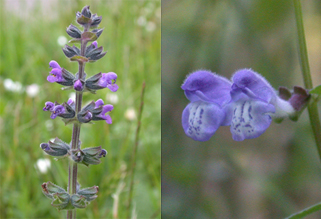 |
Blue Labiates
These plants are rather variable in appearance, but are recognised by their blue or bluish-purple flowers, all of which have the typical labiate flower shape - a tubular base with a two-lipped opening at the mouth of the flower. Some are shrubby, becoming woody at the base, while others are low, creeping plants of shady places. |
 |
Red Labiates
A small group of showy plants, mostly involving members of the genus Salvia. These plants have red or reddish-purple flowers, all of which have the typical labiate flower shape - a tubular base with a two-lipped opening at the mouth of the flower. Some species have richly-coloured bracts that help to attract the attention of insect pollinators to the flowers. |
 |
White Labiates
These plants are rather variable in appearance and many of the white-flowered labiates are simply white-flowered forms of pink or blue labiates. As a group they show the typical labiate flower shape - a tubular base with a two-lipped opening at the mouth of the flower. This is a small group of mostly rather low-growing plants of grassy places or disturbed ground. |
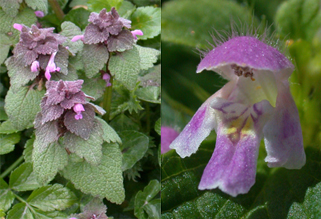 |
Dead-nettles & Allies
Typically upright plants with opposite, hairy or downy leaves and square stems. Flowers are often relatively large and showy and are carried in tight whorls around the leaf bases or in terminal spikes. Flowers may be a variety of colours, but most often pink or white and often have spots or markings. |
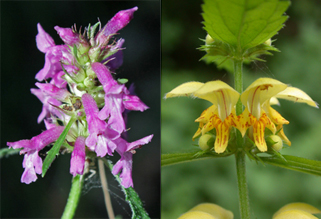 |
Dead-nettles & Allies
Typically upright plants with opposite, hairy or downy leaves and square stems. Flowers are often relatively large and showy and are carried in tight whorls around the leaf bases or in dense, terminal spikes. Flowers may be a variety of colours and may have spots or markings. |
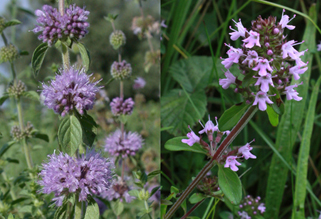 |
Thymes & Mints
This group of plants differs from most other members of the labiate family by having very small flowers with four, free petals at the mouth of the flower that are all more or less the same size. This results in the flowers looking rather different to the two-lipped appearance of other members of the family. The flowers are clustered tightly together in the leaf axils, or in terminal clusters. Some plants have upright stems, while others are low-growing and trailing. |
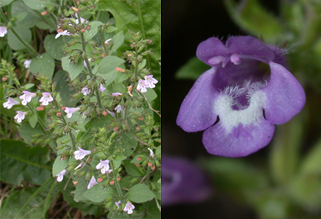 |
Balms, Savouries & Allies
A variable bunch of plants with pink or white flowers. This group of plants are mostly highly aromatic in all their parts. Their flowers are rather similar to those of the mints and thymes in not having the hooded appearance of other labiates, but the three lower lobes form a larger lip than the two upper ones. The flowers can be in tight clusters in the leaf axils, but are mostly more open and in small clusters of less than eight, or even single. |
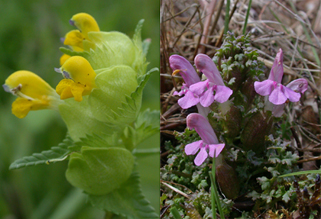 |
Non-labiates
A variety of plants that are now considered to be close relatives of the broomrapes have tubular, lipped flowers that rather resemble those of the labiates. If you have found a flower in a grassy place or a wetland that looks like a labiate but you can't find it on this page, try this link to the broomrape allies, which includes the yellow rattles, bartsias, cow-wheats and louseworts. |